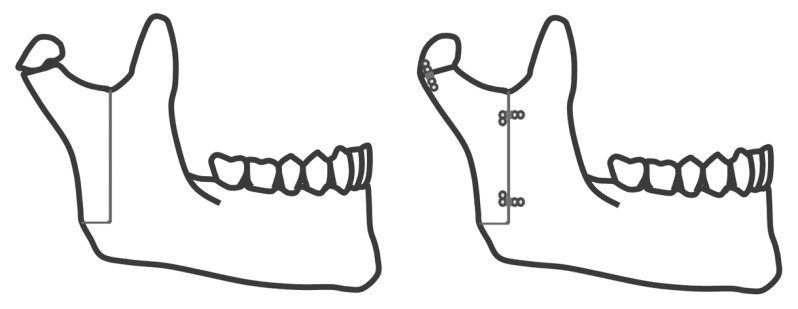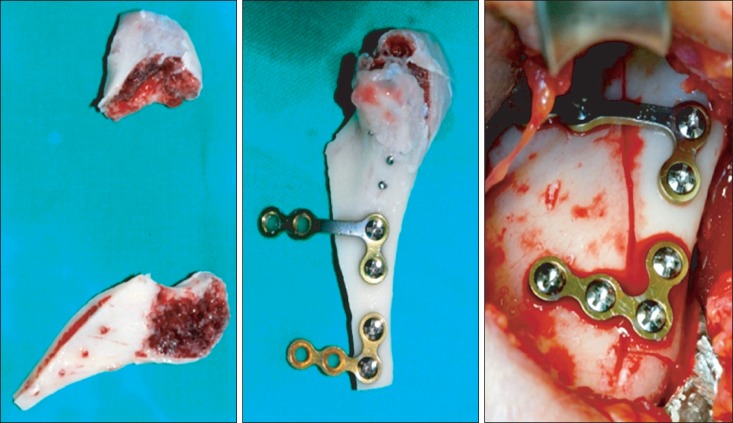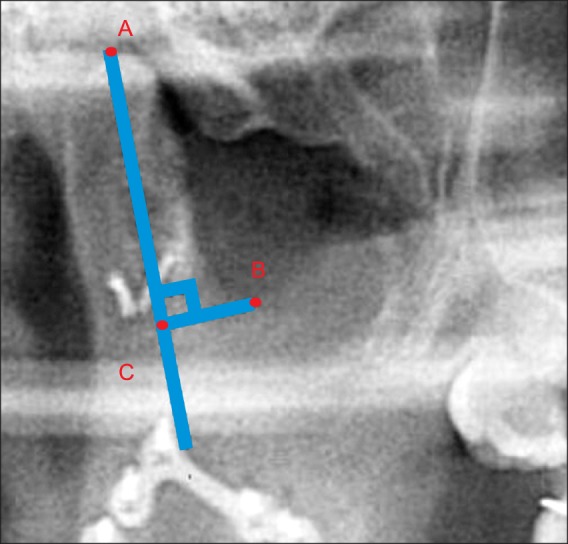J Korean Assoc Oral Maxillofac Surg.
2014 Apr;40(2):76-82. 10.5125/jkaoms.2014.40.2.76.
A follow-up study on extracorporeal fixation of condylar fractures using vertical ramus osteotomy
- Affiliations
-
- 1Department of Oral and Maxillofacial Surgery, Sun Dental Hospital, Daejeon, Korea. omsdklee@gmail.com
- KMID: 1960958
- DOI: http://doi.org/10.5125/jkaoms.2014.40.2.76
Abstract
OBJECTIVES
The aim of this study is to report the results of extracorporeal fixation in patients with mandibular condylar fractures and compare them with the clinical results of conservative treatment.
MATERIALS AND METHODS
The medical records of 92 patients (73 male [M] : 19 female [F], age 13-69 years, mean 33.1 years) treated for condylar fractures at the Department of Oral and Maxillofacial Surgery in Sun Dental Hospital (Daejeon, Korea) from 2007 to 2012 were reviewed. Patients were divided into three groups: group A (23 patients; M : F=18 : 5, age 21-69 years, mean 32.6 years), treated with extracorporeal fixation; group B (30 patients; M : F=24 : 6, age 16-57 years, mean 21.1 years), treated by conventional open reduction; and group C (39 patients; M : F=31 : 8, age 16-63 years, mean 34.4 years), treated with the conservative method ('closed' reduction). Clinical and radiographic findings were evaluated and analyzed statistically.
RESULTS
Occurrence of postoperative condylar resorption correlated with certain locations and types of fracture. In this study, patients in group A (treated with extracorporeal fixation) did not demonstrate significant postoperative complications such as malocclusion, mandibular hypomobility, temporomandibular disorder, or complete resorption of condyle fragments.
CONCLUSION
In superiorly located mandibular condyle fractures, exact reconstruction of condylar structure with the conventional open reduction technique can be difficult due to the limited surgical and visual fields. In such cases, extracorporeal fixation of the condyle using vertical ramus osteotomy may be a better choice of treatment because it results in anatomically accurate reconstruction and low risk of complications.
MeSH Terms
Figure
Cited by 2 articles
-
Commentary to "A follow-up study on extracorporeal fixation of condylar fractures using vertical ramus osteotomy"
Soung Min Kim, Ji Hyuck Kim
J Korean Assoc Oral Maxillofac Surg. 2016;42(4):236-237. doi: 10.5125/jkaoms.2016.42.4.236.Intraoral reinsertion after extracorporeal fixation in condylar fracture
Soung Min Kim
J Korean Assoc Oral Maxillofac Surg. 2021;47(6):476-479. doi: 10.5125/jkaoms.2021.47.6.476.
Reference
-
1. Ellis E 3rd, Moos KF, el-Attar A. Ten years of mandibular fractures: an analysis of 2,137 cases. Oral Surg Oral Med Oral Pathol. 1985; 59:120–129. PMID: 3856795.
Article2. da Fonseca GD. Experimental study on fractures of the mandibular condylar process (mandibular condylar process fractures). Int J Oral Surg. 1974; 3:89–101. PMID: 4209422.
Article3. Lindahl L. Condylar fractures of the mandible. I. Classification and relation to age, occlusion, and concomitant injuries of teeth and teeth-supporting structures, and fractures of the mandibular body. Int J Oral Surg. 1977; 6:12–21. PMID: 402318.4. Ellis E 3rd, Throckmorton G. Facial symmetry after closed and open treatment of fractures of the mandibular condylar process. J Oral Maxillofac Surg. 2000; 58:719–728. PMID: 10883686.
Article5. Baker AW, McMahon J, Moos KF. Current consensus on the management of fractures of the mandibular condyle. A method by questionnaire. Int J Oral Maxillofac Surg. 1998; 27:258–266. PMID: 9698171.6. Zide MF, Kent JN. Indications for open reduction of mandibular condyle fractures. J Oral Maxillofac Surg. 1983; 41:89–98. PMID: 6571887.
Article7. Raveh J, Vuillemin T, Lädrach K. Open reduction of the dislocated, fractured condylar process: indications and surgical procedures. J Oral Maxillofac Surg. 1989; 47:120–127. PMID: 2913244.
Article8. Nam IW. The condylar head and upper condylar neck fractures treated by Nam's method(III). J Korean Acad Oral Surg. 1981; 7:81–90.9. Boyne PJ. Free grafting of traumatically displaced or resected mandibular condyles. J Oral Maxillofac Surg. 1989; 47:228–232. PMID: 2921657.
Article10. Ellis E 3rd, Reynolds ST, Park HS. A method to rigidly fix high condylar fractures. Oral Surg Oral Med Oral Pathol. 1989; 68:369–374. PMID: 2797732.
Article11. Mikkonen P, Lindqvist C, Pihakari A, Iizuka T, Paukku P. Osteotomy-osteosynthesis in displaced condylar fractures. Int J Oral Maxillofac Surg. 1989; 18:267–270. PMID: 2509578.12. Brandt MT, Haug RH. Open versus closed reduction of adult mandibular condyle fractures: a review of the literature regarding the evolution of current thoughts on management. J Oral Maxillofac Surg. 2003; 61:1324–1332. PMID: 14613090.
Article13. Hidding J, Wolf R, Pingel D. Surgical versus non-surgical treatment of fractures of the articular process of the mandible. J Craniomaxillofac Surg. 1992; 20:345–347. PMID: 1464684.
Article14. Ellis E 3rd. Method to determine when open treatment of condylar process fractures is not necessary. J Oral Maxillofac Surg. 2009; 67:1685–1690. PMID: 19615583.
Article15. Eckelt U. Tension bolt osteosynthesis for fractures of the mandibular condyle. Dtsch Z Mund Kiefer Gesichtschir. 1991; 15:51–57. PMID: 1814666.16. Bell WH, Kennedy JW 3rd. Biological basis for vertical ramus osteotomies--a study of bone healing and revascularization in adult rhesus monkeys. J Oral Surg. 1976; 34:215–224. PMID: 815526.17. Daniels S, Ellis E 3rd, Carlson DS. Histologic analysis of costochondral and sternoclavicular grafts in the TMJ of the juvenile monkey. J Oral Maxillofac Surg. 1987; 45:675–683. PMID: 3302188.
Article18. Gupta MV, Sahoo CNK. Extracorporeal fixation of displaced mandibular condylar fracture: viable option. Med J Armed Forces India. 2009; 65:229–231.19. Davis BR, Powell JE, Morrison AD. Free-grafting of mandibular condyle fractures: clinical outcomes in 10 consecutive patients. Int J Oral Maxillofac Surg. 2005; 34:871–876. PMID: 15955668.
Article
- Full Text Links
- Actions
-
Cited
- CITED
-
- Close
- Share
- Similar articles
-
- Commentary to "A follow-up study on extracorporeal fixation of condylar fractures using vertical ramus osteotomy"
- Intracorporeal reduction of condylar fracture using both pedicled condylar and seperated ramal fragments after vertical ramal osteotomy
- A clinical study on fractures of the mandibular condyles: effective extracorporeal fixation technique
- Unilateral intraoral vertical ramus osteotomy and sagittal split ramus osteotomy for the treatment of asymmetric mandibles
- The changes of condylar position after orthognathic surgery in patients with skeletal Class III malocclusion






